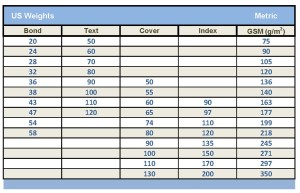Common printing papers

Understanding printing paper types and weights can be difficult. With so many choices, trying to get this seemingly simple decision completed can take undue time when you’re juggling so many other issues. Yet it can be devastating if your printed materials arrive on the wrong stock. For example, what if you’re accustomed to communicating about paper in GSM and your printer only understands LBS (pounds)? It’s important to your end results to know which stock and weight to request.
Trust us, we understand how frustrating it can be. All too often clients are unfamiliar with how to express their printing paper needs when requesting printed materials. So we here at Ferrante & Associates have put together a simple chart along with a few additional terms needed in order to simplify the different options.
Most commonly used printing paper stocks: 
Formula:
1lb. of text paper = 1.48 gsm. Multiply each pound of text paper by 1.48.
1lb. of cover paper = 2.708 gsm. Multiply each pound of cover paper by 2.708
Points: Every point = .001 inch. Example 10pt card = .010 ins.
Types of printing papers:
Most common: Uncoated, Gloss, Dull, Matte, Silk and Velvet .
Note: many printers offer “house” sheets that are lower in cost than the particular brands that customers might specify. These house stocks are offered at reduced rates because printers receive discounts for purchasing large volumes of that particular stock and the savings can be passed on to customers.
Many paper brands measure paper brightness using one of two scales
Industry standards are based upon the light-reflecting property of paper when measured under a specially calibrated blue light. The higher the number, the brighter the sheet. And the brighter white the sheet, the stronger the contrast.
Bond versus White Wove

White Wove basically means it’s not linen, not laid, not columnar, not textured, not coated, not finished, and most affordable. It is a basic type and finish in making paper and most commonly used is 20lb. and 24lb. It has a smooth uncoated finish.
Bond refers to high quality longer fiber sheet, free of impurities. Used for strength and resistance to damage when folded.
Did you know?
The same printing paper can be called by different names. The terms “paperweight” and number corresponding with each weight refer to the thickness and sturdiness of the paper, not the actual weight of the sheet. This is why sometimes the same “weight” paper may be referred to as two different things.
For example, regular everyday copy paper is most commonly referred to as 20lb. bond but at other times it is referred to as 50lb. text weight. To eliminate as much confusion as possible, below are bond versus LBS, for stocks that are similar in weight but called by different names. LBS stands for pounds and GSM stands for grams per square meter.
Bond/Text weights in pounds (LBS)
20lb. bond/50lb. text:
Is often used for everyday copy machines. Because it is uncoated it is widely used for projects involving pencil, pen and felt-tip marker. Bond paper can sometimes contain rag fiber pulp, which produces a stronger, though rougher, sheet of paper.
24lb. bond/60lb. text:
Multipurpose paper most used in office printers and for business letterhead
28lb. bond/70lb. text
Often used for brochures and presentations. Caution: make sure you check with your printer about show-through on two sided printing.
32lb. bond / 80lb. text
Slightly heavier than 28lb, used most often for brochures and presentations.
Common Papers
Index
This is a thin paper often used for business card reply cards. It is an inexpensive paper with a smooth finish.
Text Wt.
Great stock with a soft feel, good for menus, posters, brochures and text pages within catalogs, programs and brochures. For offset printing we suggest 60lb, 70lb, 80lb, 100lb, 120lb and 130lb. Note: in lighter weight text stock and depending on the brand and your design needs, some text weight sheets will have possible show-through issues. Best to check with your print supplier.
Cover Wt.
Heavyweight paper used for invitations, program covers, postcards, tabs, dividers, folders and brochures, to name a few. Please note: scoring required before any folding. 60lb, 70lb, 80lb, 100lb, 120lb and 130lb.
Points Wt. (pt)
Refers to the thickness of an individual sheet. Great for folders and presentations. These papers are typically board grade, come coated one side C1S or two sided C2S and are slightly lower quality than paper measured in pounds. If the project requires high stiffness, point stocks are heavier than stocks measured in pounds (lb.). If you want a thicker and sturdier paper stock, use pt. stocks. Otherwise, you are better served using lb. paper stocks since they are flexible and can be easily folded without being scored.
We hope the information above helps when you need to choose the stock that best fits your needs.
Best of Days to You,
Audrey Ferrante
Ferrante & Associates, Inc.
 Let’s connect
Let’s connect
If you’d like to learn more about how we think here at Ferrante & Associates, subscribe to our blogs or our monthly Newsletter Ferrante Speaks. You may also follow us on Twitter, Google+ or Facebook.
Don’t miss out: Subscribe and receive regular updates delivered automatically via a web portal, newsreader or email.







